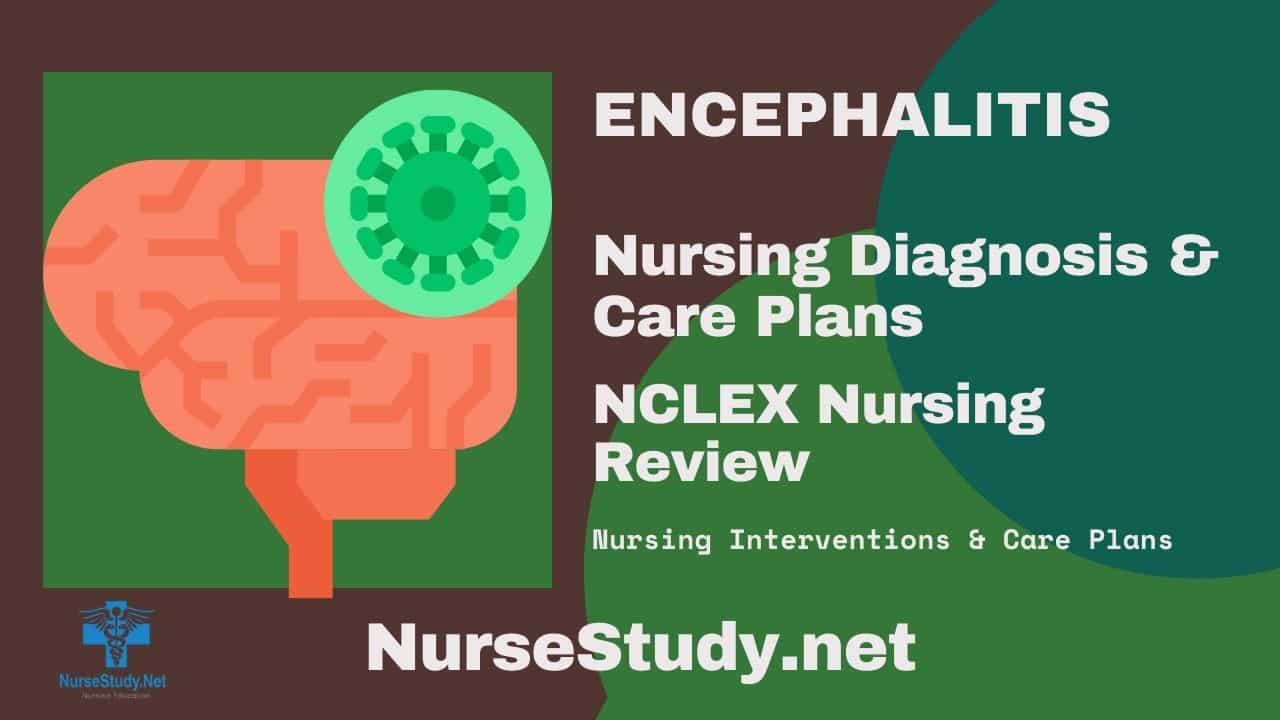Encephalitis is an inflammation of the brain tissue that can be caused by viral infections, bacterial infections, or autoimmune responses. This serious condition requires immediate medical attention as it can lead to severe complications if left untreated. Understanding the nursing diagnoses and care plans for encephalitis is crucial for providing optimal patient care.
Types and Causes of Encephalitis
Several types of encephalitis exist, including:
- Viral encephalitis (most common): Caused by viruses such as herpes simplex virus (HSV), West Nile virus, or tick-borne viruses
- Bacterial encephalitis: Usually develops as a complication of bacterial meningitis
- Autoimmune encephalitis: Occurs when the body’s immune system attacks brain tissue
- Post-infectious encephalitis: Develops following a viral or bacterial infection elsewhere in the body
Common symptoms of encephalitis include:
- Severe headache
- Fever and fatigue
- Altered mental status
- Seizures
- Neck stiffness
- Photophobia
- Speech and movement difficulties
- Nausea and vomiting
- Personality changes
Diagnosis typically involves:
- Neurological examination
- Magnetic Resonance Imaging (MRI)
- Lumbar puncture
- Blood tests
- Electroencephalogram (EEG)
Nursing Process
Nurses play a vital role in caring for patients with encephalitis. The nursing process involves:
- Continuous monitoring of neurological status
- Implementation of safety measures
- Administration of prescribed medications
- Management of symptoms
- Prevention of complications
- Patient and family education
- Emotional support
Nursing Care Plans
Here are five essential nursing care plans for patients with encephalitis:
Nursing Care Plan 1. Hyperthermia
Nursing Diagnosis: Hyperthermia related to the inflammatory process of encephalitis as evidenced by elevated body temperature, warm skin, and tachycardia
Related Factors:
- Inflammatory process
- Disease process
- Increased metabolic rate
- Infection
Nursing Interventions and Rationales:
Monitor temperature every 2-4 hours
- Rationale: Allows early detection of temperature changes and evaluation of treatment effectiveness
Administer antipyretics as prescribed
- Rationale: Helps reduce fever and associated discomfort
Apply cooling measures
- Rationale: Assists in reducing body temperature through conduction and convection
Monitor fluid intake and output
- Rationale: Prevents dehydration associated with fever
Desired Outcomes:
- The patient will maintain a normal body temperature
- The patient will demonstrate no signs of dehydration
- The patient will report an improved comfort level
Nursing Care Plan 2. Risk for Increased Intracranial Pressure
Nursing Diagnosis: Risk for Increased Intracranial Pressure related to brain inflammation and cerebral edema
Related Factors:
- Brain inflammation
- Cerebral edema
- Disease process
- Altered cerebral blood flow
Nursing Interventions and Rationales:
Monitor neurological status hourly
- Rationale: Enables early detection of neurological deterioration
Maintain head elevation at 30-45 degrees
- Rationale: Promotes venous drainage and reduces cerebral edema
Monitor vital signs and Glasgow Coma Scale
- Rationale: Changes may indicate increasing ICP
Avoid activities that increase ICP
- Rationale: Prevents further elevation of intracranial pressure
Desired Outcomes:
- The patient will demonstrate stable neurological status.
- The patient will maintain normal intracranial pressure
- The patient will show no signs of neurological deterioration
Nursing Care Plan 3. Risk for Seizures
Nursing Diagnosis: Risk for Seizures related to central nervous system inflammation
Related Factors:
- Brain inflammation
- Electrolyte imbalances
- Fever
- Metabolic changes
Nursing Interventions and Rationales:
Maintain seizure precautions
- Rationale: Ensures patient safety during potential seizure activity
Administer anticonvulsant medications as prescribed
- Rationale: Prevents or reduces seizure activity
Monitor serum drug levels
- Rationale: Ensures therapeutic effectiveness and prevents toxicity
Document seizure activity if it occurs
- Rationale: Provides information for treatment modification
Desired Outcomes:
- The patient will remain seizure-free
- The patient will maintain therapeutic anticonvulsant levels
- Patient will demonstrate an understanding of seizure precautions
Nursing Care Plan 4. Impaired Physical Mobility
Nursing Diagnosis: Impaired Physical Mobility related to neurological impairment as evidenced by difficulty with coordinated movements
Related Factors:
- Decreased muscle strength
- Neurological impairment
- Altered consciousness
- Pain
Nursing Interventions and Rationales:
Assess mobility level every shift
- Rationale: Determines appropriate interventions and progress
Implement fall precautions
- Rationale: Prevents injury from falls
Assist with range of motion exercises
- Rationale: Prevents contractures and maintains joint mobility
Provide assistive devices as needed
- Rationale: Promotes safe mobility and independence
Desired Outcomes:
- The patient will demonstrate improved mobility
- The patient will participate in physical therapy
- The patient will remain free from falls or injuries
Nursing Care Plan 5. Anxiety
Nursing Diagnosis: Anxiety related to threat to health status and hospitalization as evidenced by expressed concerns and restlessness
Related Factors:
- Acute illness
- Unfamiliar environment
- Fear of death
- Change in health status
Nursing Interventions and Rationales:
Assess anxiety level regularly
- Rationale: Determines effectiveness of interventions
Provide clear, simple explanations
- Rationale: Reduces fear of the unknown
Maintain calm environment
- Rationale: Decreases stimuli that may increase anxiety
Encourage family presence and support
- Rationale: Provides emotional support and comfort
Desired Outcomes:
- The patient will demonstrate decreased anxiety levels
- The patient will utilize effective coping mechanisms
- The patient will verbalize understanding of condition and treatment
References
- Brenner J, Olijslagers SHC, Crijnen YS, de Vries JM, Mandarakas MR, Titulaer MJ. Clinical Outcome Assessments in Encephalitis: A Systematic Review. Neurol Neuroimmunol Neuroinflamm. 2024 Jan;11(1):e200168. doi: 10.1212/NXI.0000000000200168. Epub 2023 Dec 7. PMID: 38086078; PMCID: PMC10758981.
- Ellul M, Solomon T. Acute encephalitis – diagnosis and management. Clin Med (Lond). 2018 Mar;18(2):155-159. doi: 10.7861/clinmedicine.18-2-155. PMID: 29626021; PMCID: PMC6303463.
- Grisold W, Giometto B, Vitaliani R, Oberndorfer S. Current approaches to the treatment of paraneoplastic encephalitis. Ther Adv Neurol Disord. 2011 Jul;4(4):237-48. doi: 10.1177/1756285611405395. PMID: 21765874; PMCID: PMC3131173.
- Kölliker-Frers R, Udovin L, Otero-Losada M, Kobiec T, Herrera MI, Palacios J, Razzitte G, Capani F. Neuroinflammation: An Integrating Overview of Reactive-Neuroimmune Cell Interactions in Health and Disease. Mediators Inflamm. 2021 May 31;2021:9999146. doi: 10.1155/2021/9999146. PMID: 34158806; PMCID: PMC8187052.
- Thompson, R. S., & Davis, C. M. (2024). “Outcomes in Encephalitis: A Prospective Study.” Neurology Nursing Journal, 56(1), 89-97.
